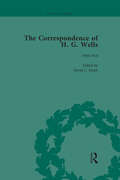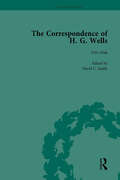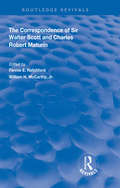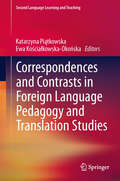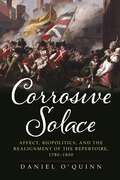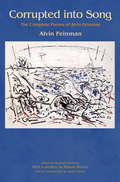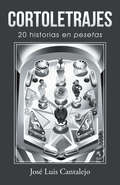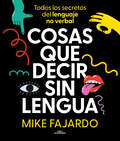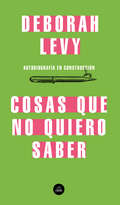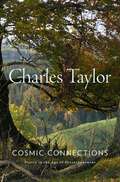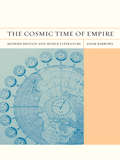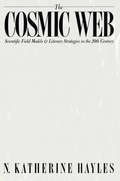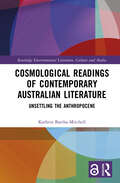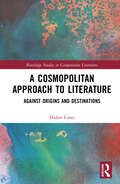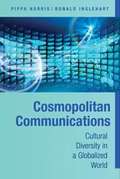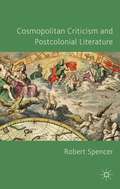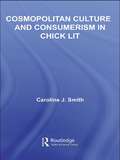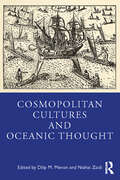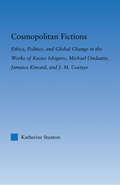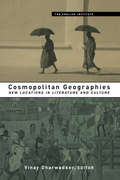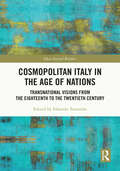- Table View
- List View
The Correspondence of H G Wells Vol 2
by H G Wells David Smith Patrick ParrinderThis collection of H.G. Wells's correspondence draws on over 50 archives and libraries worldwide, including the papers of Wells's daughter by Amber Reeves. The book contains over 2000 letters, both business and personal. Wells's private correspondence includes letters to Winston Churchill.
The Correspondence of H G Wells Vol 3
by H G Wells David Smith Patrick ParrinderThis collection of H.G. Wells's correspondence draws on over 50 archives and libraries worldwide, including the papers of Wells's daughter by Amber Reeves. The book contains over 2000 letters, both business and personal. Wells's private correspondence includes letters to Winston Churchill.
The Correspondence of H G Wells Vol 4
by H G Wells David Smith Patrick ParrinderThis collection of H.G. Wells's correspondence draws on over 50 archives and libraries worldwide, including the papers of Wells's daughter by Amber Reeves. The book contains over 2000 letters, both business and personal. Wells's private correspondence includes letters to Winston Churchill.
The Correspondence of Sir Walter Scott and Charles Robert Maturim (Routledge Revivals)
by Fannie E. Ratchford William H. McCarthyOriginally published in 1937, The Correspondence of Sir Walter Scott and Charles Robert Maturin contains twenty-two letters presenting a penetrating and vivid self-portrait of Sir Walter Scott. Scott's patronage of Maturin, this impecunious Irish author, giving him wise advice, lending encouragement in his work and at times badly needed financial assistance, extended over a period of twelve years to the time of Maturin's death, and his kind subsequent letters, written to Maturin's family, in the midst of his own great financial troubles, bring to a fitting close this single unit in Scott's rich social life. Since the two men never met, the whole relationship was built up through thier literary work and their letters to each other, displayed in this volume.
Correspondences and Contrasts in Foreign Language Pedagogy and Translation Studies (Second Language Learning and Teaching)
by Ewa Kościałkowska-Okońska Katarzyna PiątkowskaThe book constitutes a selection of 18 papers on foreign language pedagogy (11 papers) and translation studies (9 papers). The first part of the book is devoted to foreign language pedagogy. The articles in this part focus on issues such as English as lingua franca, foreign language teacher training, the role of individual learner differences in language learning and teaching especially with respect to strategies of language learning as well as psychological and socioaffective factors. The part focusing on translation studies comprises articles devoted to a variety of topics. It places a wide range of readings within the context of varying translation domains such as translation competence, literary translation, translation strategies, translation teaching (including strategies of dictionary use) and translator training. The combination of the above aspects intends to underline the truly interdisciplinary nature of translation.
Corridor: Media Architectures in American Fiction
by Kate MarshallCorridor offers a series of conceptually provocative readings that illuminate a hidden and surprising relationship between architectural space and modern American fiction. By paying close attention to fictional descriptions of some of modernity&’s least remarkable structures, such as plumbing, ductwork, and airshafts, Kate Marshall discovers a rich network of connections between corridors and novels, one that also sheds new light on the nature of modern media.The corridor is the dominant organizational structure in modern architecture, yet its various functions are taken for granted, and it tends to disappear from view. But, as Marshall shows, even the most banal structures become strangely visible in the noisy communication systems of American fiction. By examining the link between modernist novels and corridors, Marshall demonstrates the ways architectural elements act as media. In a fresh look at the late naturalist fiction of the 1920s, &’30s, and &’40s, she leads the reader through the fetus-clogged sewers of Manhattan Transfer to the corpse-choked furnaces of Native Son and reveals how these invisible spaces have a fascinating history in organizing the structure of modern persons. Portraying media as not only objects but processes, Marshall develops a new idiom for Americanist literary criticism, one that explains how media studies can inform our understanding of modernist literature.
Corrosive Solace: Affect, Biopolitics, and the Realignment of the Repertoire, 1780-1800
by Daniel O'QuinnIn Corrosive Solace, Daniel O’Quinn argues that the loss of the American colonies instantiated a complex reorganization in sociability and politics in the British metropole that has had long-lasting effects on British national and imperial culture, which can be seen and analyzed within its performative repertoire. He examines how the analysis of feeling or affect can be deployed to address the inchoate causal relation between historical events and their mediation. In this sense, Corrosive Solace’s goals are twofold: first, to outline the methodologies necessary for dealing with the affective recognition of historical crisis; and second, to make the historically familiar strange again, and thus make visible key avenues for discussion that have remained dormant. Both of these objectives turn on recognition: How do we theorize the implicit affective recognition of crisis in a distant historical moment? And how do we recognize what we, in our present moment, cannot discern?Corrosive Solace addresses this complex cultural reorientation by attending less to “new” cultural products than to the theoretical and historical problems posed by looking at the transformation of “old” plays and modes of performance. These “old” plays—Shakespeare, post-Restoration comedy and she-tragedy—were a vital plank of the cultural patrimony, so much of O’Quinn’s analysis lies in how tradition was recovered and redirected to meet urgent social and political needs. Across the arc of Corrosive Solace, he tracks how the loss of the American War forced Britons to refashion the repertoire of cultural signs and social dispositions that had subtended its first empire in the Atlantic world in a way more suited to its emergent empire in South Asia.
Corrupted into Song: The Complete Poems of Alvin Feinman
by Harold Bloom Deborah Dorfman James Geary Alvin FeinmanAccording to Harold Bloom, "The best of Alvin Feinman's poetry is as good as anything by a twentieth-century American. His work achieves the greatness of the American sublime." Yet, in part because he published so sparsely, Feinman remained little-read and largely unknown when he died in 2008. This definitive edition of Feinman's complete work, which includes fifty-seven previously published poems and thirty-nine unpublished poems discovered among his manuscripts, introduces a new generation of readers to the lyrical intensity and philosophical ambition of this major American poet. Harold Bloom, a lifelong friend of Feinman, provides a preface in which he examines Feinman's work in the context of the strongest poets of his generation--John Ashbery, James Merrill, and A. R. Ammons--while the introduction by James Geary, who studied with Feinman at Bennington College, presents a biographical and critical sketch of this remarkable poet and teacher. Corrupted into Song restores Feinman's work to its rightful place alongside that of poets like Hart Crane and Wallace Stevens, with whom his poetry and poetics have so much in common.
Cortoletrajes: 20 historias en pesetas
by José Luis Cantalejo«20 historias cortas que te harán reír, llorar y disfrutar volviendo a los tiempos en los que todavía vivíamos "en pesetas".» <P><P>Cortoletrajes reúne veinte relatos, diez de ellos premiados en diferentes concursos literarios. Veinte historias escritas en los años 80 y 90, cuando pagábamos en pesetas y existían los carretes de fotos, las cabinas telefónicas, las máquinas de escribir... <P>Aunque muy diferentes entre sí, los relatos cuentan con un estilo propio en el que la tensión narrativa sumerge al lector en las historias para que viva, junto a los protagonistas, sus éxitos y sus fracasos. La locura, el amor, la traición, el paso del tiempo todo ello está presente en Cortoletrajes. También la ironía, la magia, los toques surrealistas... <P>Veinte relatos en los que nada es lo que parece y en los que la sorpresa final está garantizada.
Cosas que decir sin lengua: Todos los secretos del lenguaje no verbal
by Mike FajardoMike Fajardo te enseña un montón de curiosidades y trucos sobre la comunicación no verbal para que aprendas a interpretar qué dice la gente cuando no abre la boca. ¿Sabes detectar si una persona está mintiendo? ¿Qué significa que alguien te frunza el ceño? ¿Crees que puedes saber si eres bienvenido en un lugar por la posición de los pies de las personas que te reciben? Y, sobre todo, ¿hay manera de saber, sin preguntarlo, si a esa persona que tanto te gusta también le gustas tú?A partir de ahora, los gestos y los guiños ya no tendrán secretos para ti. En estas páginas encontrarás explicaciones sencillas a por qué cruzamos las piernas en una conversación, los trucos para hablar en público, las técnicas para adelantarnos a los movimientos de los demás y, por supuesto, las claves básicas para interpretar si le gustamos a esa persona.
Cosas que no quiero saber
by Deborah LevyPrimera parte de la «autobiografía en construcción» de Deborah Levy, un relato de la feminidad como libertad y no como castigo. Deborah Levy arranca estas memorias recordando la etapa de su vida en que rompía a llorar cuando subía unas escaleras mecánicas. Ese movimiento inocuo la llevaba a rincones de su memoria a los que no quería volver. Son esos recuerdos los que forman Cosas que no quiero saber, el inicio de su «autobiografía en construcción». Esta primera parte de lo que será un tríptico sobre la condición de ser mujer nace como respuesta al ensayo «Por qué escribo», de George Orwell. Sin embargo, Levy no viene a dar respuestas. Viene a abrir interrogantes que deja flotando en una atmósfera formada por toda la fuerza poética de su escritura. Su magia no es otra que la de las conexiones impredecibles de la memoria: el primer mordisco a un albaricoque la traslada a la salida de sus hijos de la escuela, observando a las otras madres, «jóvenes convertidas en sombras de lo que habían sido»; el llanto de una mujer le devuelve la nieve cayendo sobre su padre en el Johannesburgo del apartheid, poco antes de ser encarcelado; el olor del curry la lleva a su adolescencia en Londres, escribiendo en servilletas de bares y soñando con una habitación propia. Leer a Levy es querer entrar en sus recuerdos y dejarse llevar por la calma y el aplomo de quien ha aprendido todo lo que sabe (y todo lo que no querría saber) a fuerza de buscar su propia voz. Reseñas:«Imprescindible. Leerla es como encontrar un oasis.»The Guardian «El punto fuerte de Levy es su originalidad de pensamiento y expresión.»Jeanette Winterson «Una narración vivaz y brillante sobre cómo los detalles más inocentes de la vida personal de una escritora pueden alcanzar el poder en la ficción.»The New York Times Book Review «Un relato vívido y sorprendente de la vida de la escritora, que feminiza y personaliza las contundentes a afirmaciones de Orwell.»The Spectator «Levy es una escritora hábil y crea un despliegue de emociones intensas en una prosa precisa y controlada.»The Independent «Una versión actualizada de Una habitación propia [...]. Sospecho que será citado durante muchos años.»The Irish Examiner
Cosmic Connections: Poetry in the Age of Disenchantment
by Charles TaylorA major new work by Charles Taylor: the long-awaited follow-up to The Language Animal, exploring the Romantic poetics central to his theory of language.The Language Animal, Charles Taylor’s 2016 account of human linguistic capacity, was a revelation, toppling scholarly conventions and illuminating our most fundamental selves. But, as Taylor noted in that work, there was much more to be said. Cosmic Connections continues Taylor’s exploration of Romantic and post-Romantic responses to disenchantment and innovations in language.Reacting to the fall of cosmic orders that were at once metaphysical and moral, the Romantics used the symbols and music of poetry to recover contact with reality beyond fragmented existence. They sought to overcome disenchantment and groped toward a new meaning of life. Their accomplishments have been extended by post-Romantic generations into the present day. Taylor’s magisterial work takes us from Hölderlin, Novalis, Keats, and Shelley to Hopkins, Rilke, Baudelaire, and Mallarmé, and on to Eliot, Miłosz, and beyond.In seeking deeper understanding and a different orientation to life, the language of poetry is not merely a pleasurable presentation of doctrines already elaborated elsewhere. Rather, Taylor insists, poetry persuades us through the experience of connection. The resulting conviction is very different from that gained through the force of argument. By its very nature, poetry’s reasoning will often be incomplete, tentative, and enigmatic. But at the same time, its insight is too moving—too obviously true—to be ignored.
The Cosmic Time of Empire: Modern Britain and World Literature
by Adam BarrowsCombining original historical research with literary analysis, Adam Barrows takes a provocative look at the creation of world standard time in 1884 and rethinks the significance of this remarkable moment in modernism for both the processes of imperialism and for modern literature. As representatives from twenty-four nations argued over adopting the Prime Meridian, and thereby measuring time in relation to Greenwich, England, writers began experimenting with new ways of representing human temporality. Barrows finds this experimentation in works as varied as Victorian adventure novels, high modernist texts, and South Asian novels--including the work of James Joyce, Virginia Woolf, H. Rider Haggard, Bram Stoker, Rudyard Kipling, and Joseph Conrad. Demonstrating the investment of modernist writing in the problems of geopolitics and in the public discourse of time, Barrows argues that it is possible, and productive, to rethink the politics of modernism through the politics of time.
The Cosmic Web: Scientific Field Models and Literary Strategies in the Twentieth Century
by N. Katherine HaylesFrom the central concept of the field—which depicts the world as a mutually interactive whole, with each part connected to every other part by an underlying field— have come models as diverse as quantum mathematics and Saussure’s theory of language. In The Cosmic Web, N. Katherine Hayles seeks to establish the scope of the field concept and to assess its importance for contemporary thought. She then explores the literary strategies that are attributable directly or indirectly to the new paradigm; among the texts at which she looks closely are Robert Pirsig’s Zen and the Art of Motorcycle Maintenance, Nabokov’s Ada, D. H. Lawrence’s early novels and essays, Borges’s fiction, and Thomas Pynchon’s Gravity’s Rainbow.
Cosmological Readings of Contemporary Australian Literature: Unsettling the Anthropocene (Routledge Environmental Literature, Culture and Media)
by Kathrin Bartha-MitchellThis book presents an innovative and imaginative reading of contemporary Australian literature in the context of unprecedented ecological crisis. The Australian continent has seen significant, rapid changes to its cultures and land-use from the impact of British colonial rule, yet there is a rich history of Indigenous land-ethics and cosmological thought. By using the age-old idea of ‘cosmos’—the order of the world—to foreground ideas of a good order and chaos, reciprocity and more-than-human agency, this book interrogates the Anthropocene in Australia, focusing on notions of colonisation, farming, mining, bioethics, technology, environmental justice and sovereignty. It offers ‘cosmological readings’ of a diverse range of authors—Indigenous and non-Indigenous—as a challenge to the Anthropocene’s decline-narrative. As a result, it reactivates ‘cosmos’ as an ethical vision and a transculturally important counter-concept to the Anthropocene. Kathrin Bartha-Mitchell argues that the arts can help us envision radical cosmologies of being in and with the planet, and to address the very real social and environmental problems of our era. This book will be of particular interest to scholars and students of Ecocriticism, Environmental Humanities, and postcolonial, transcultural and Indigenous studies, with a primary focus on Australian, New Zealand, Oceanic and Pacific area studies.
Cosmology and the Polis
by Richard SeafordThis book further develops Professor Seaford's innovative work on the study of ritual and money in the developing Greek polis. It employs the concept of the chronotope, which refers to the phenomenon whereby the spatial and temporal frameworks explicit or implicit in a text have the same structure, and uncovers various such chronotopes in Homer, the Homeric Hymn to Demeter, Presocratic philosophy and in particular the tragedies of Aeschylus. Mikhail Bakhtin's pioneering use of the chronotope was in literary analysis. This study by contrast derives the variety of chronotopes manifest in Greek texts from the variety of socially integrative practices in the developing polis - notably reciprocity, collective ritual and monetised exchange. In particular, the Oresteia of Aeschylus embody the reassuring absorption of the new and threatening monetised chronotope into the traditional chronotope that arises from collective ritual with its aetiological myth. This argument includes the first ever demonstration of the profound affinities between Aeschylus and the (Presocratic) philosophy of his time.
A Cosmopolitan Approach to Literature: Against Origins and Destinations (Routledge Studies in Comparative Literature)
by Didier CosteThis cross-disciplinary approach to literary reading of any provenance based on an “experimental cosmopolitan” epistemology de- and recontextualizes the texts from the points of view of multiple cultures and historical moments, enriching interpretation and aesthetic experience beyond the backgrounds of the present reader and the origin of a particular literary discourse. Trusting the authority of an author or an “original” text and ignoring the fundamental plurilingualism of the literary experience obstructs the wealth of cosmopolitan reading in a globalized and fragmented world. A thorough critique of both local and overarching theories in clear dissent from the binaries of “decolonial theory” and the overextension of “nomadic theory” supports a precise research and teaching methodology at variance with past trends of Comparative and World Literature. Considering literature as the aestheticized use of language, which is universal, the many analyses provided can be extrapolated to other genres, eras, and cultural areas.
Cosmopolitan Communications: Cultural Diversity in a Globalized World
by Pippa Norris Ronald InglehartSocieties around the world have experienced a flood of information from diverse channels originating beyond local communities and even national borders, transmitted through the rapid expansion of cosmopolitan communications. For more than half a century, conventional interpretations, Norris and Inglehart argue, have commonly exaggerated the potential threats arising from this process. A series of fire-walls protect national cultures. This book develops a new theoretical framework for understanding cosmopolitan communications and uses it to identify the conditions under which global communications are most likely to endanger cultural diversity. The authors analyze empirical evidence from both the societal level and the individual level, examining the outlook and beliefs of people in a wide range of societies. The study draws on evidence from the World Values Survey, covering 90 societies in all major regions worldwide from 1981 to 2007. The conclusion considers the implications of their findings for cultural policies.
Cosmopolitan Criticism and Postcolonial Literature
by Robert SpencerVia readings of novels by J. M. Coetzee, Timothy Mo and Salman Rushdie and the later poetry of W. B. Yeats, this book reveals how postcolonial writing can encourage the enlarged sense of moral and political responsibility needed to supplant ongoing forms of imperial violence with cosmopolitan institutions, relationships and ways of thinking.
Cosmopolitan Culture and Consumerism in Chick Lit (Literary Criticism and Cultural Theory)
by Caroline J. SmithCosmopolitan Culture and Consumerism in Chick Lit focuses on the literary phenomenon popularly known as chick lit, and the way in which this genre interfaces with magazines, self-help books, romantic comedies, and domestic-advice publications. This recent trend in women’s popular fiction, which began in 1996 with the publication of British author Helen Fielding’s novel Bridget Jones’s Diary, uses first person narration to chronicle the romantic tribulations of its young, single, white, heterosexual, urban heroines. Critics of the genre have failed to fully appreciate chick lit’s complicated representations of women as both readers and consumers. In this study, Smith argues that chick lit questions the "consume and achieve promise" offered by advice manuals marketed toward women, subverting the consumer industry to which it is so closely linked and challenging cultural expectations of women as consumers, readers, and writers, and of popular fiction itself.
Cosmopolitan Cultures and Oceanic Thought
by Dilip M. Menon Nishat ZaidiThis book imagines the ocean as central to understanding the world and its connections in history, literature and the social sciences. Introducing the central conceptual category of ocean as method, it analyzes the histories of movement and traversing across connected spaces of water and land sedimented in literary texts, folklore, local histories, autobiographies, music and performance. It explores the constant flow of people, material and ideologies across the waters and how they make their presence felt in a cosmopolitan thinking of the connections of the world. Going beyond violent histories of slavery and indenture that generate global connections, it tracks the movements of sailors, boatmen, religious teachers, merchants, and adventurers. The essays in this volume summon up this miscegenated history in which land and water are ever linked. A significant rethinking of world history, this volume will be of great interest to scholars and researchers of history, especially connected history and maritime history, literature, and Global South studies.
Cosmopolitan Fictions: Ethics, Politics, and Global Change in the Works of Kazuo Ishiguro, Michael Ondaatje, Jamaica Kincaid, and J. M. Coetzee (Literary Criticism and Cultural Theory)
by Katherine StantonParticipating in the reframing of literary studies, Cosmopolitan Fictions identifies, as "cosmopolitan fiction", a genre of global literature that investigates the ethics and politics of complex and multiple belonging. The fictions studied by Katherine Stanton represent and revise the global histories of the past and present, including the "indigenous or native" narratives that are, in Homi Bhabha's words, "internal to" national identity itself. The works take as their subjects: * European unification* the human rights movement* the AIDS epidemic* the new South Africa. And they test the infinite demands for justice against the shifting borders of the nation, rethinking habits of feeling, modes of belonging and practices of citizenship for the global future. Scholars, teachers and students of global literary and cultural studies, Cosmopolitan Fictions is a book to want on your reading list.
Cosmopolitan Geographies: New Locations in Literature and Culture (Essays from the English Institute)
by Vinay DharwadkerThis book highlights the best new interdisciplinary research on the theory and practice of cosmopolitanism, with a special focus on the cosmopolitan literatures of Europe, Asia, Africa, and North America, from medieval times to the present.
Cosmopolitan Greetings: Poems 1986-1992
by Allen GinsbergHalf a century after "founding" the Beat Generation, Allen Ginsberg has written this powerful collection of poems that are suffused with a range of emotional colors that gives Ginsberg's work an elegiac tone.
Cosmopolitan Italy in the Age of Nations: Transnational Visions from the Eighteenth to the Twentieth Century (Ideas beyond Borders)
by Edoardo TortaroloModern Italian historiography has undergone a substantial revision in the last quarter of a century. From an almost exclusive focus on the process of nation-building, the attention of historians has shifted. The most innovative research is now devoted to assessing to what extent the cosmopolitan attitude that was evident in the late eighteenth century morphed, but did not disappear, in the ensuing two centuries. The essays in this volume make the case that the age of nations had a profound impact on Italian history and contributed to the creation of an Italian identity within the framework of well-functioning imperial and global networks. They also acknowledge that the process of national individualization carried with it a variety of aspects that reconnected Italian history to the foreign cultures that were undergoing constant self-fashioning. Cosmopolitan Italy in the Age of Nations: Transnational Visions from the Eighteenth to the Twentieth Century will be of interest to scholars throughout the world and intellectual and transnational historians.
